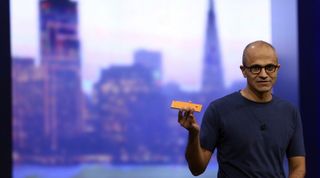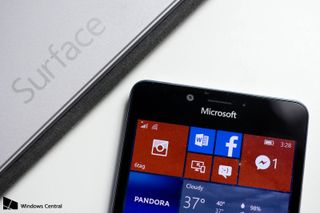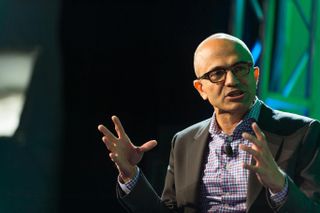This is what has to happen first in order for a Surface phone to succeed
If there's one thing die-hard Windows phone fans are awaiting it is the much-anticipated Surface phone.

Though it has never been explicitly confirmed, Microsoft CEO Satya Nadella's "device beyond the curve in mobile" and "ultimate mobile device" statements suggest that a post-smartphone category-defining Surface is coming. Chief Marketing Officer, Chris Capossela, recently alluded to the same.

My own predictions of a category-defining ultramobile Surface date back to January 2015; and Windows 10 on ARM and the potential of Win32 apps joining Universal Apps via the Centennial Bridge on a post-smartphone device seem to be moving us toward that vision.
Of course, the success of that vision relies heavily on other factors.
The Surface phone will launch when its ready.
Just as the Surface family and HoloLens remained secrets until they were ready, the same holds true for what many are calling a Surface phone. Redmond has stressed the device must be unique and category-defining before it launches.
Beyond the engineering required to develop unique hardware that we presume will be context-conforming like that of the rest of the Surface family there are other things that must be in place to prepare for the Surface "phone."
A plan for recovery and success

My ongoing analysis of Microsoft's mobile strategy has highlighted Redmond's self-inflicted harm such as a late reentry into the mobile space, poor marketing and limited distribution in addition to external factors. But Microsoft must have a position in mobile to succeed. And they know it.
The Surface phone has never been Microsoft's sole hope for mobile.
The Surface phone has never been Microsoft's sole hope for its mobile strategy. Though I'm a die-hard Windows phone fan, I've stressed the role of the ecosystem and even conceded that:
Get the Windows Central Newsletter
All the latest news, reviews, and guides for Windows and Xbox diehards.
In the two years since, time and technology have brought my prediction of a cellular-capable Surface PC, the reimagining of the "smartphone," closer to reality. Still, the success of that vision rests precariously on the future of Microsoft's App Bridges, AI and bots investments, manufacturer partnerships, the UWP and Microsoft's biggest differentiator: Continuum.
Microsoft must succeed in various areas of its ecosystem investments on which the mobile strategy depends if the Surface phone is to succeed.
Putting all their ducks in a row

Microsoft's initial steps toward recovery involved retrenching its mobile efforts. Nadella's focus during this period was: "to grow and create a vibrant Windows ecosystem that includes our first-party device family."
Though the company no longer makes Lumia smartphones, an ultramobile Surface, as a first-party device, will fit in that strategy. For the ultramobile Surface to succeed Microsoft's investment's in the following areas of their ecosystem must also succeed.
Apps
Though my Gartner-confirmed prediction suggests apps will decline in usage, they still have a place. Microsoft currently has the Westminster (Web), IslandWood (iOS) and Centennial (Win32) app Bridges in place to bring more apps to the Universal Windows Platform. With Windows on ARM, I expect a big push of Centennial and hope for a greater push of the other Bridges as we move into 2017.
AI and Bots
Microsoft's Conversation as a platform strategy positions AI and bots as the next evolution of apps toward an intelligent app ecosystem. Redmond has also democratized Cortana and has over 40,000 developers as part of its Bot's Framework.
Partnerships
Manufacturer partnerships are critical to Microsoft's ecosystem strategy. The initial retrenching and the more controversial exit of first-party hardware allows partners like HP, Alcatel and others to fill the space that was previously dominated by Lumias.
Furthermore, the IDC reported: "…1Q16 also saw the introduction of detachable tablets from traditional "mobile first" vendors like Samsung and Huawei."
I presented an analysis on traditional PC makers and mobile-first vendors crossing over into common territory:
The ability of these manufactures to adapt their device portfolios from a "PC to mobile" or "mobile to PC" category indicates a capability of manufacturing a device that represents a confluence of both.…I foresee a personal computing landscape where Microsoft's efforts to bring the phone and PC together ultimately cause mobile-first and PC manufacturers to compete in the same space.
Microsoft's cellular PC strategy presents the ideal platform for the realization of this vision.
The UWP
Microsoft's UWP is vital to its mobile strategy in that Windows is Windows on all devices be they PC's, 2-in-1s, HoloLens or some as yet unintroduced devices. As Microsoft introduces new features like those coming in Redstone 3 the OS that will power the anticipated Surface phone is being continually improved.
Mindshare
Redmond needs current and potential smartphone users to recognize that the company has a play in the cellular-connected world of mobile computing. Windows 10 on ARM and the potential deluge of cellular PCs OEM partners will bring to the market will be poised to do just that beginning late 2017.
Celluar PCs may be just the forerunner the Surface phone needs.
These cellular PCs may be just the precursor to market the Surface phone needs. As a new type of always-connected Windows PC they will help pave a path, in the collective minds of the industry, for Microsoft's mobile strategy of an ultramobile Surface that will run legacy and Modern apps and become a PC via Microsoft's key differentiator: Continuum.
Carriers
Finally, Microsoft must nurture relationships with carriers as they are the primary device distribution channels to consumers.
Surface phone cometh
As Microsoft prepares for what is presumed to be a 2018 launch of the Surface phone I foresee 2017 being a runway where Redmond greatly ramps up efforts in building its ecosystem.
I anticipate a much stronger push of all of the App Bridges, but notably Centennial as they prepare to bring Win32 apps to ARM.

I expect an increased push of its AI and bots initiative, an aggressive refining of Windows 10, further revelations of Microsoft's strategy to provide cellular connectivity, renewed efforts to build relationships with carriers and deeper relationships with OEM partners which will include marketing.
It will be the confluence of success in these areas throughout 2017 that will be the foundation for the innovative hardware Devices Chief Panos Panay and team will bring to the table as a category-defining ultramobile Surface in 2018. That is, if we're are not surprised with something this year of course.
Will Microsoft's multifaceted ecosystem-building plan work? Time will tell.
Following the Story
- Windows phone isn't dead
- Smartphones are dead
- The untold app gap story
- AIs, Bots and Canvases
- Microsoft and the duo user
- Windows Mobile and the enterprise
- The Surface Phone
Jason L Ward is a columnist at Windows Central. He provides unique big picture analysis of the complex world of Microsoft. Jason takes the small clues and gives you an insightful big picture perspective through storytelling that you won't find *anywhere* else. Seriously, this dude thinks outside the box. Follow him on Twitter at @JLTechWord. He's doing the "write" thing!

